Diving straight into a messy art project at the beginning of a school year might be crazy, but I do it anyway. I adore watching kids paint and they love to do it, so it’s a win-win. This painted paper lesson has huge benefits: teaches little kids how to hold a brush, how to make big brush strokes, how to follow a set of instructions and how to create texture. And that’s just for step one.
The biggest challenge begins on step two when the kids are asked to turn various rectangles into shapes. Here’s what the Kinders did in the first two weeks of art class:
Creating Painted Paper
I have many projects covering how to make painted paper, so I won’t go into the details in this post. The paint set-up is just slightly different for this project compared to many of my other painted paper projects. I used plastic cards, toilet paper rolls and sponges to use as texture tools instead of rollers. Children created two painted papers each.
After the paper dries, sort the paper into colors. Cut each color group into various size rectangles. I cut small rectangles (for wheels), medium size (for cabs) and big for the main parts of the trucks. Place a variety of sizes and colors into tin-foil trays for table groups.
Making the Trucks
On the second day, the Kinders sat in front of me on the floor. I showed them drawings and photographs of big rig trucks, firetrucks, delivery trucks. If you have time to read a book, I’d recommend Dig, Dogs, Dig: A Construction Tail by James Horvath. The kids will love it and the book will help identify the names of the common vehicles on a construction site.
We talked about the basic components of a truck: the cab where the driver sits, the body of the truck, the wheel base and the wheels. We counted wheels on some of the trucks in the picture (and a few kids doubled that sum to figure out how many total wheels the truck had). Then, I pulled out the rectangles and demonstrated how to create a truck.
To make wheels, I cut circles from the small rectangles. Depending on the ability range of your Kinders, it might be helpful to use round plastic cups. Remember, drawing and cutting a circle is challenging for 5th graders, so don’t feel like you are compromising the skill development if you choose to use a template.
I demonstrated how to cut an angle line off one side of the “cab” rectangle to make a windshield. We talked about trapezoids and how to make one from a rectangle. As we spoke about the different shapes, I cut them out and placed on a colored piece of paper on the whiteboard. The truck appeared slowly, much to the delight of the kids.
This is the order I used:
- Cut wheels (2)
- Cut wheel base (long, skinny rectangle)
- Cut cab (medium rectangle with a triangle cut out)
- Main body (trapezoid for a dump truck)
- Details like headlights, ladders and hub caps can be made if you have time)
Before you scroll down and see the wonderful trucks made by my 5 years olds, remember that this can be a very challenging project for young Kinders. One year makes a huge difference in skill set for spatial awareness, listening skills and cutting/gluing skills. One of my classes has nine 4-year olds, many of whom didn’t know how to operate scissors. It was the cutest thing really. One girl was completely mystified as the strange looking device.
Other kids (4 and 5 year olds) have developing awareness for objects, so many of the trucks looked like the one below. Some kids understood how a truck looks, but lacked scissor experience so the process was very slow. Other kids couldn’t quite follow all of the instructions, so missed the part about gluing down the truck. Not a big problem, but when it was time to clean up and “put all the paper scraps” in the recycling bin, so did the carefully cut-out trucks. Yup. It happened.
But remember the big picture: After this lesson, the children will be one step closer to mastering a higher skill level.
For most kids in my three Kinder classes, the trucks came together really well. Some kids created cement trucks by using organic shapes and another placed two trapezoids together. Lots of firetrucks with cut out ladders and a few trucks decorated with oil pastels. A great start to the school year, I think!
Now my question for you….
How do you introduce shapes to Kinders? Do you have a good lesson to share?

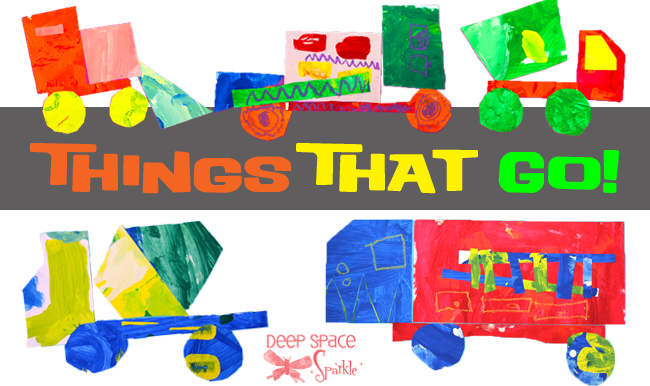





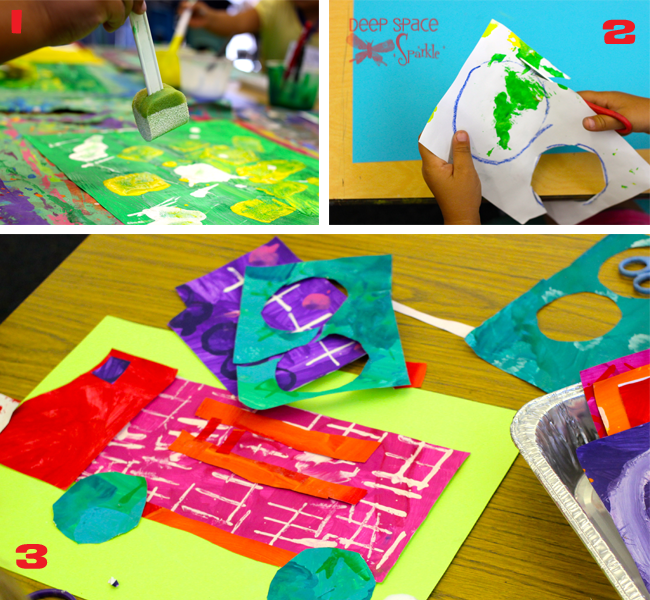
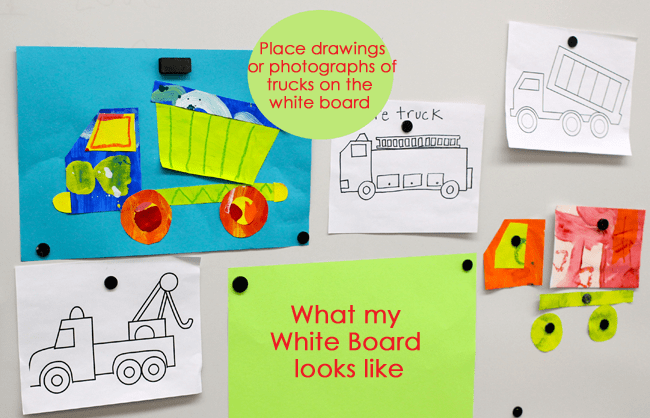
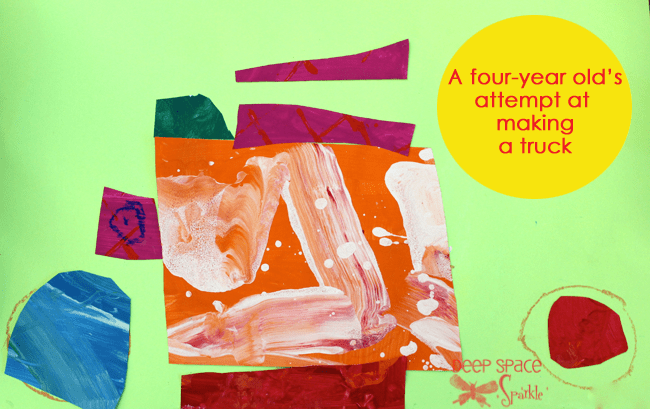
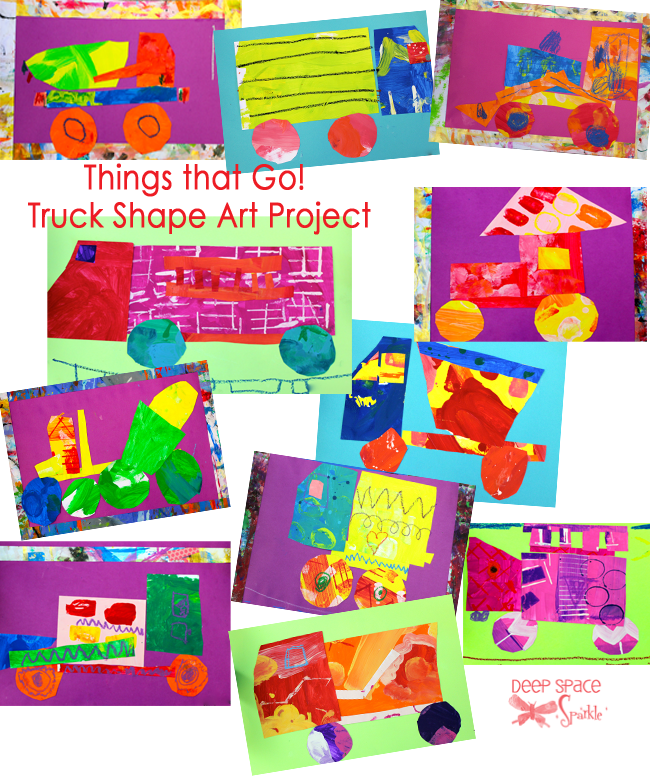





LOVE, LOVE, LOVE these !!!! Another great lesson! Thanks!
So cute! I think I will make some for my son’s room.
As an aside why in the world are there 4 year olds in your kinder classes? They are super strict about the kids needing to be five to start kinder here in Oregon.
I have 9″ x 12″ sheets of white felt for each student and tons of squares, circles, and triangles in different sizes cut out of red, yellow, and blue felt. I dump a pile on each table and we “build” things together. “Pick out a square and a circle and place them together to make a dog. Add two little triangles for ears., etc, etc.” There is a book called ‘Drawing Shape by Shape” by Chris Hart that gives me tons of material. After we do a few together, I let the kids come up with their own designs. It was a lot of work to make the shapes in the beginning, but I use these over and over every year.
I have a couple of 4 year olds too. Since I’m at a Charter School I can only guess that the parents probably bribed the Registrar.
This sounds like a GREAT lesson! I love making painted papers with my K-3 age children. They love the process, and they often are thrilled with their color options when the next project begins.
When I do SHAPE with my K & 1 kids, I have old kitchen sponges cut into geometric shapes. I distribute them in a tray with diluted tempera paint and encourage them to build objects with basic shapes. The next week, we use sharpies to add details (lines & dots) to “help your viewer understand what they are looking at” I have had good success with this lesson and often have kids request more opportunities to explore with the sponges later in the year.
hi,
thank you for sharing such a great article with us.hey are super strict about the kids needing to be five to start kinder here in Oregon.
Patty,
These are really adorable aside from being such a great skill building activity!
I’m also glad to see such a perfect use for the painted paper…..a project my classes LOVED on our first day.
Thank you for your energy and enthusiasm. It very inspiring!
Ronda
What a wonderful project! I especially love that the kids were encouraged to create their own trucks and not all told to produce exactly the same thing. In my daughter’s K class all the art projects come out exactly the same, because they have to copy the teacher exactly– even down to what color crayon they have to use. It makes me sad that they don’t they don’t seem to allow any creative freedom at all. Is this common?
Hi Sue,
Sometimes, when children are doing art in regular classrooms, everything is assessed: how well a child can cut, follow directions, etc. It’s less about creativity. If a child takes the lesson down another path, it might be considered not following directions. This may not be the case, but it might be. Another reason for similar art is that the teacher is comfortable doing it this way. It’s easier to teach 25 kinders to cut one square to make this and a rectangle to make something else, then to accommodate every child’s desire to create something different. I don’t have a huge problem with things looking exactly the same way because I know that it is difficult for some teachers to do otherwise. That’s my goal with this blog…to show that you can teach a manageable lesson and allow the kids to have some creative flexibility.
I love this and am thinking about using it with 2nd graders. With K kids I do a build up of shape lessons. I start the first one by reading them I Spy Shapes in Art, by Lucy Mickelthwaite. We get to see several different pieces of art work, identifying the named shape in each. The last page has the kids spot 10 circles. From this we do a collage where the kids are to choose 10 pre-punch shapes and create a collage. Then, if we have time, on another piece of paper, they take shape stencils, and color in the shapes. Some choose to create a specific object with their 10 shapes, others (most) are much more random. Our following lesson looks at Mondrian, and recreating a piece based on his red/yellow/blue compositions.
Thanks for the inspiration! I used this lesson idea to continue my introduction of the element of art-Shape, AND to introduce painting without having the students focus on painting anything in particular. I also have realized that I need to do more with cutting and gluing, so this was the perfect lesson for it. I shared it on my blog here: http://conantelementaryart.blogspot.com/2014/01/shape-collage-moving-vehicles-grade-k.html, linking back to yours for credit.
As an extension, I asked the librarian to pull a collection of moving vehicle picture books, that we briefly looked at for inspiration, but they were also available for students who finished more quickly then others. I’ve been doing that more with my k students, and it’s been a great success.
Just checked out your blog, Melissa. Love what you did with the background. So cute!
I accidentally posted on another project. Our Kinders just did this project today. I had a little boy decide to trim his hair. After I told him that scissors are for paper only, he “accidentally” cut a little chunk out of his trousers. Kinders They are an adventure.
Terrific Trucks!
At the beginning of the school year, my kindergartners complete a unit on both colors and shapes and after a couple weeks we read the story Dig, Dig, Digging by Margaret Mayo in our reading series. I absolutely love this art lesson. It introduces painting materials, brush strokes, and color mixing to my students for them to freely explore the art materials at the beginning of the school year. Then they get the opportunity to cut shapes and create their favorite “Things that Go!” It is a colorful and amazing finished product. After they are glued onto colored construction paper we talk about giving our art work sound and they add some writing to their art work as well using Onomatopoeia. This is a fairly easy form of writing for them because kindergartners are working on adding letters for the sounds they hear so “Rrrrr” and “Vroom” are new and easy ways for them to write words and instantly know what it says. It is an amazing display in the hallway and it is all thanks to this project and the inspiration from you!
Thanks for including the parts of the lessons that didn’t go as planned. It always helps to know your not the only one that this stuff happens to!
Thanks for sharing, I will get your painted paper lesson plans. Do you have the truck pictures you used as examples on file?